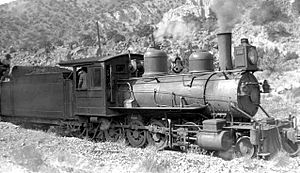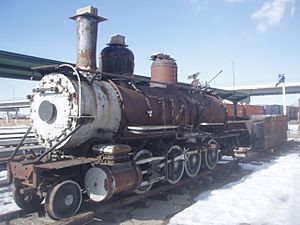Grant Locomotive Works facts for kids
Grant Locomotive Works was a company that built steam locomotives. These are powerful trains that run on steam! The company operated from 1867 to 1895. It first started in Paterson, New Jersey, and later moved to Chicago. During its time, Grant Locomotive Works built around 1,888 locomotives.
Contents
How Grant Locomotive Works Started
The story of Grant Locomotive Works began in 1842. Three men, Samuel Smith, Abram Collier, and George Bradley, opened a small factory in Paterson, New Jersey. Over time, partners changed. In 1848, a new company was formed called Swinburne, Smith and Company.
This company quickly got an order to build ten locomotives for the New York and Erie Railroad. A few years later, it officially became the New Jersey Locomotive and Machine Company.
Then, between 1863 and 1864, Oliver De Forest Grant bought the company. He ran it with his sons, David B. Grant and R. Suydam Grant. After Oliver Grant passed away, his son David became the president.
The Famous Consolidation Locomotive
Grant Locomotive Works is famous for a type of train called the 2-8-0 Consolidation locomotive. This design was created in 1866 by Alexander Mitchell. He was a master mechanic for the Lehigh Valley Railroad.
At first, other big locomotive builders like Baldwin and Rogers didn't want to build this new design. But Grant Locomotive Works offered to build it. Later, in 1881, when Baldwin couldn't keep up with orders, Grant helped out. They built Consolidation locomotives for the Denver & Rio Grande Western Railroad. One of the two Grant-built locomotives still existing today, D&RGW 223, is a Consolidation type.
Challenges and Moving to Chicago
In 1867, the company officially became Grant Locomotive Works. The company faced some tough times financially. In 1872, their boilermakers went on strike for better pay. Grant replaced them with new workers for less money.
In 1874, the Russian Empire ordered 55 Consolidation locomotives. But there were problems, and the Russians ended up canceling 20 of the orders.
David Grant retired in 1880, and William W. Evans took over. The company was quite busy, completing 110 engines in 1881. By 1882, they had 720 workers and a large factory space. However, in 1887, a big fire destroyed half of their buildings.
After the fire, some business people from Chicago convinced the company to move there. They spent a lot of money building new factories and buying new machines. But after building only 24 engines in Chicago, a worker strike and a financial crisis in 1893 forced the company to close down.
Locomotives Built by Grant
Grant Locomotive Works built trains for many different railroads across the United States. They built for at least 134 different companies!
Some of the railroads they built for include:
- Baltimore and Ohio
- Boston and Maine
- Chateaugay R.R.
- Central Pacific
- Chesapeake & Ohio
- Chicago & Alton Railroad
- Chicago and North Western Railway
- Chicago, Burlington & Quincy
- Chicago, Milwaukee & St. Paul
- Chicago, Rock Island & Pacific
- Delaware, Lackawanna & Western
- Denver & Rio Grande
- Erie Railway
- Grand Trunk Western
- Great Northern
- Lehigh Valley
- Michigan Central
- Missouri, Kansas & Texas
- New York & New Haven
- Norfolk & Western
- Northern Pacific
- Pennsylvania
- Richmond, Fredericksburg & Potomac
- Seaboard Airline
- Texas & St. Louis Ry.
- Toledo, Cincinnati and St. Louis Railroad
- Union Pacific
- Utah Northern
- Western Maryland
Until the early 1870s, most of the locomotives they built were "Americans" (4-4-0s). They also made some "switchers" (0-6-0s), "Moguls" (2-6-0s), and "Ten Wheelers" (4-6-0s). They even built 22 "eight-wheel switchers" (0-8-0s) for the B&O railroad.
The order from the Russian government was for their first "2-8-0" type locomotives. In 1878, they built 35 "Columbias" (2-4-2s) for an elevated railway in Manhattan. From 1878 to 1882, they built 96 "Consolidations" for the New York, Lake Erie & Western railroad.
Grant also built narrow-gauge trains. Their first order for these smaller trains came from the Utah Northern in 1871. These were "2-4-0" type locomotives. In 1881, the Denver and Rio Grande ordered 30 narrow-gauge "Consolidations."
One interesting order in 1887 was for a "2-6-2 Prairie" tank locomotive. This train was for a mining company in China called the Chinese Engineering and Mining Company. A picture of this special engine still exists today!




